TOT BRAC International
Abstract
BRAC International started its global journey in 2002 in Afghanistan, and since then it expanded its activities in nine other developing countries in Asia and Africa, making it a global leader in providing opportunities for the world’s poor on a non-profit basis. BRAC believes to eradicate poverty from not only its parent country but also from the whole world. The number of workforce of BRAC International is above 8000 staff meaning there is an enormous involvement of human resource activity. Except Philippines, all other BRAC International countries have their own small department of Human Resource and Training and an HR Team with very few members in it. This particular department is responsible in handling all the operations, managing employees’ performances and their capacity building. Although I worked as an intern and I could not get much of a holistic view of the company yet the responsibilities I was assigned with was enough for me to at least anticipate their ways of operation the organization’s culture and most importantly the organizational behavior. I have done a brief SWOT analysis to find out BRAC’s strengths and weaknesses based on which I prepared some of my recommendations. Their topmost strength is that they have a tremendous HR and Training department who actually knows their work and can recognize talent while hiring and also gives their best during training the employees for the capacity expansion. However one of their major drawbacks is that BRAC works behind the scene. Although some say that BRAC does not believe in publicity and the work they are doing it is not for being good in the public’s eye. On the other hand there are people saying that being an NGO it becomes difficult for the organization to gather money and prepare a huge budget for the advertisement of their work. Before having any final remarks about this report, it is requested to keep in mind that it was prepared in a very short time’s notice, and because of confidentiality, data could not be collected properly to do the analysis. Yet it would reflect an in depth knowledge upon the HR processes and the Training and Development Programs activities of the world’s largest NGO with over 40 years of experience of working with humans.

